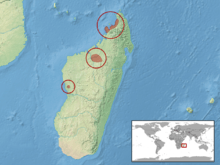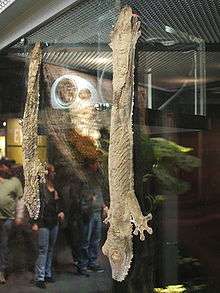Henkel's leaf-tailed gecko
Henkel's leaf-tailed gecko (Uroplatus henkeli ), also known commonly as Henkel's flat-tailed gecko or the frilled leaf-tail gecko,[2] is a species of gecko, a lizard in the family Gekkonidae. The species is endemic to Madagascar.
| Henkel's leaf-tailed gecko | |
|---|---|
 | |
| Scientific classification | |
| Kingdom: | Animalia |
| Phylum: | Chordata |
| Class: | Reptilia |
| Order: | Squamata |
| Family: | Gekkonidae |
| Genus: | Uroplatus |
| Species: | U. henkeli |
| Binomial name | |
| Uroplatus henkeli Böhme & Ibisch, 1990 | |
 | |
| Geographic range of Uroplatus henkeli. | |
Geographic range
U. henkeli is found in primary forest on the island of Nosy Bé near Madagascar, as well as on the mainland of Madagascar itself, in the region of Ankaranafantsika.[1]
Behaviour
Henkel's leaf-tailed gecko lives an arboreal lifestyle, often venturing down to the ground only to lay eggs in soft soil and leaf litter.
Description
There are two different morphs of U. henkeli, the Nosy Bé form and the mainland Madagascar form, and they can be distinguished by their colouration patterns, though these are not always reliable. Reaching a total length (including tail) of 280 mm (11 in), this is one of largest species in the genus.
Diet
Henkel's flat-tailed gecko is insectivorous, but will also eat snails if they are found.
Etymology
The generic name, Uroplatus, is a Latinization of two Greek words: "ourá" (οὐρά) meaning "tail" and "platys" (πλατύς) meaning "flat". The specific name, henkeli, is a Latinization of German herpetologist Friedrich-Wilhelm Henkel's last name.[2]
Threats
Henkel's leaf-tailed gecko is currently classified as vulnerable by the IUCN. Habitat destruction and deforestation in Madagascar is the primary threat to this animal's future as well as collection for the pet trade. The World Wide Fund for Nature (WWF) lists all of the Uroplatus species on their "Top ten most wanted species list" of animals threatened by illegal wildlife trade, because of it "being captured and sold at alarming rates for the international pet trade". It is a CITES Appendix 2 protected animal.[1][3]

References
- Raxworthy CJ, Vences M (2010). "Uroplatus henkeli ". IUCN Red List of Threatened Species. 2010: e.T178653A7589062. doi:10.2305/IUCN.UK.2010-4.RLTS.T178653A7589062.en.
- Beolens, Bo; Watkins, Michael; Grayson, Michael (2011). The Eponym Dictionary of Reptiles. Baltimore: Johns Hopkins University Press. xiii + 296 pp. ISBN 978-1-4214-0135-5. (Uroplatus hedersoni, p. 121).
- "Inclusion of Uroplatus spp. in Appendix II" (PDF). Technical comments in support of amendments to CITES appendices submitted by Madagascar. CITES. 2004. Archived from the original (PDF) on 23 November 2008. Retrieved 2 November 2008.
